battery RENAULT TWINGO RS 2009 2.G Electrical Equipment - Petrol Injection Workshop Manual
[x] Cancel search | Manufacturer: RENAULT, Model Year: 2009, Model line: TWINGO RS, Model: RENAULT TWINGO RS 2009 2.GPages: 348
Page 7 of 348
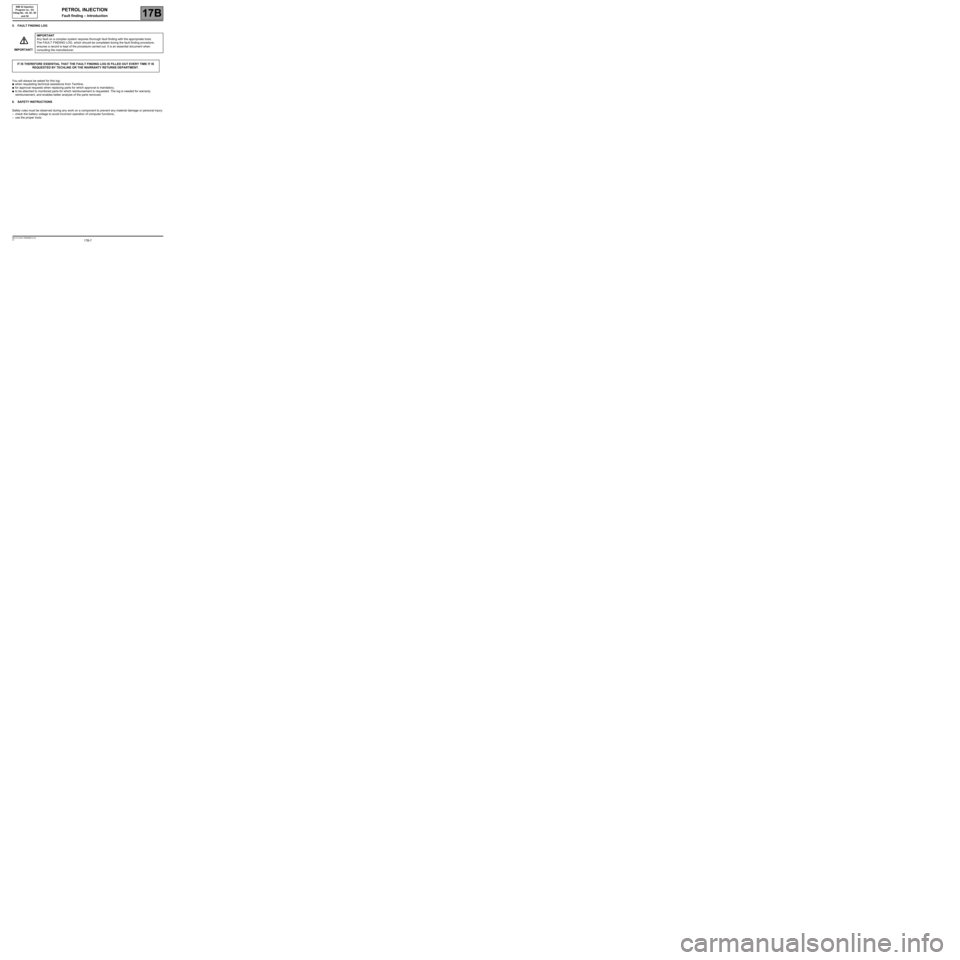
17B-7V7 MR-413-X44-17B000$010.mif
PETROL INJECTION
Fault finding – Introduction17B
SIM 32 Injection
Program no.: D3
Vdiag No.: 44, 4C, 50
and 54
5. FAULT FINDING LOG
You will always be asked for this log:
●when requesting technical assistance from Techline,
●for approval requests when replacing parts for which approval is mandatory,
●to be attached to monitored parts for which reimbursement is requested. The log is needed for warranty
reimbursement, and enables better analysis of the parts removed.
6. SAFETY INSTRUCTIONS
Safety rules must be observed during any work on a component to prevent any material damage or personal injury:
–check the battery voltage to avoid incorrect operation of computer functions,
–use the proper tools. IMPORTANT!IMPORTANT
Any fault on a complex system requires thorough fault finding with the appropriate tools.
The FAULT FINDING LOG, which should be completed during the fault finding procedure,
ensures a record is kept of the procedure carried out. It is an essential document when
consulting the manufacturer.
IT IS THEREFORE ESSENTIAL THAT THE FAULT FINDING LOG IS FILLED OUT EVERY TIME IT IS
REQUESTED BY TECHLINE OR THE WARRANTY RETURNS DEPARTMENT.
Page 13 of 348
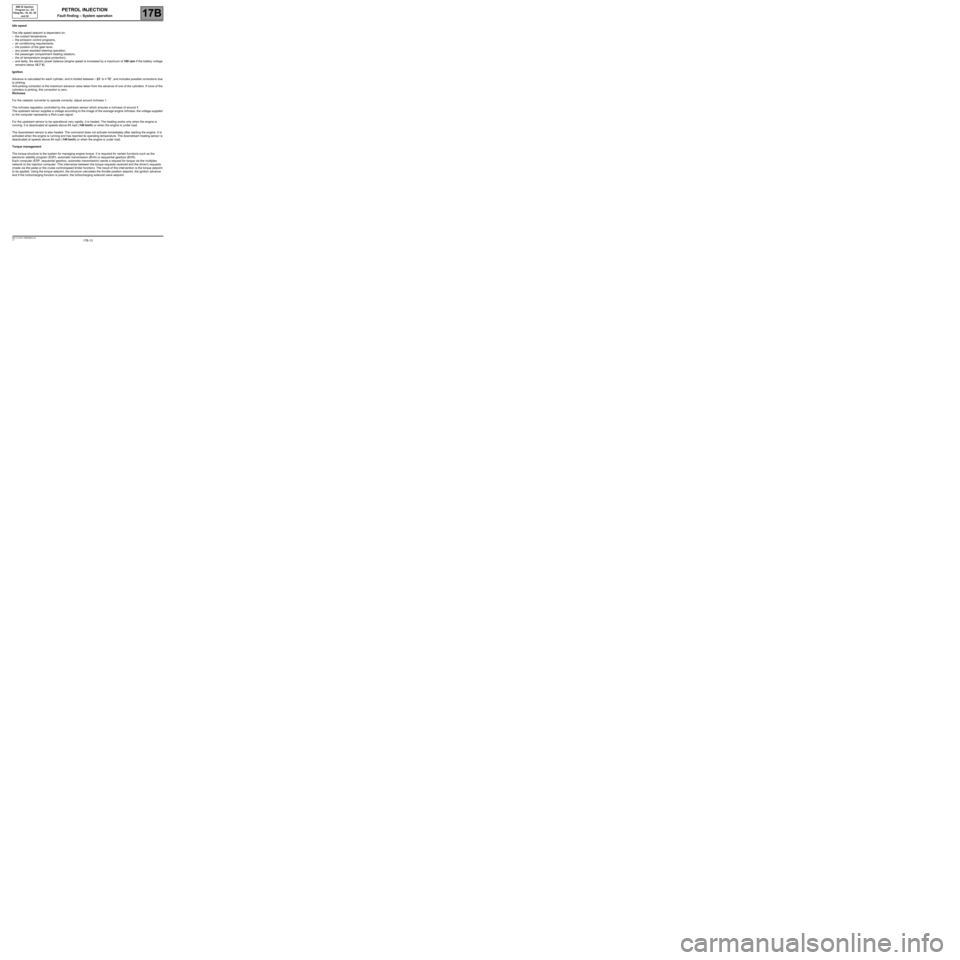
17B-13V7 MR-413-X44-17B000$030.mif
PETROL INJECTION
Fault finding – System operation17B
SIM 32 Injection
Program no.: D3
Vdiag No.: 44, 4C, 50
and 54
Idle speed
The idle speed setpoint is dependent on:
–the coolant temperature,
–the emission control programs,
–air conditioning requirements,
–the position of the gear lever,
–any power-assisted steering operation,
–the passenger compartment heating resistors,
–the oil temperature (engine protection),
–and lastly, the electric power balance (engine speed is increased by a maximum of 160 rpm if the battery voltage
remains below 12.7 V).
Ignition
Advance is calculated for each cylinder, and is limited between - 23˚ to + 72˚, and includes possible corrections due
to pinking.
Anti-pinking correction is the maximum advance value taken from the advance of one of the cylinders. If none of the
cylinders is pinking, this correction is zero.
Richness
For the catalytic converter to operate correctly, adjust around richness 1.
The richness regulation controlled by the upstream sensor which ensures a richness of around 1.
The upstream sensor supplies a voltage according to the image of the average engine richness: the voltage supplied
to the computer represents a Rich-Lean signal.
For the upstream sensor to be operational very rapidly, it is heated. The heating works only when the engine is
running. It is deactivated at speeds above 84 mph (140 km/h) or when the engine is under load.
The downstream sensor is also heated. The command does not activate immediately after starting the engine. It is
activated when the engine is running and has reached its operating temperature. The downstream heating sensor is
deactivated at speeds above 84 mph (140 km/h) or when the engine is under load.
Torque management
The torque structure is the system for managing engine torque. It is required for certain functions such as the
electronic stability program (ESP), automatic transmission (BVA) or sequential gearbox (BVR).
Each computer (ESP, sequential gearbox, automatic transmission) sends a request for torque via the multiplex
network to the injection computer. This intervenes between the torque requests received and the driver's requests
(made via the pedal or the cruise control/speed limiter function). The result of this intervention is the torque setpoint
to be applied. Using the torque setpoint, the structure calculates the throttle position setpoint, the ignition advance
and if the turbocharging function is present, the turbocharging solenoid valve setpoint.
Page 16 of 348
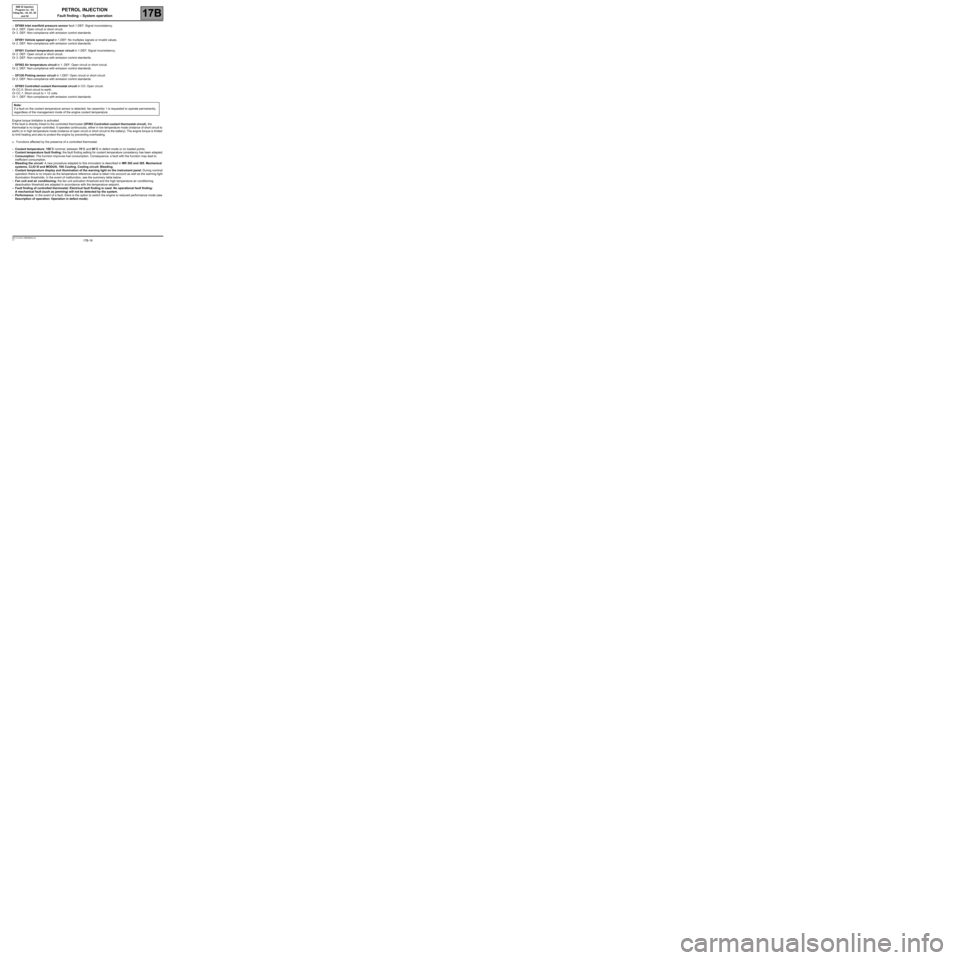
17B-16V7 MR-413-X44-17B000$030.mif
PETROL INJECTION
Fault finding – System operation17B
SIM 32 Injection
Program no.: D3
Vdiag No.: 44, 4C, 50
and 54
–DF089 Inlet manifold pressure sensor fault 1.DEF: Signal inconsistency.
Or 2. DEF: Open circuit or short circuit.
Or 3. DEF: Non-compliance with emission control standards.
–DF091 Vehicle speed signal in 1.DEF: No multiplex signals or invalid values.
Or 2. DEF: Non-compliance with emission control standards.
–DF001 Coolant temperature sensor circuit in 1.DEF: Signal inconsistency.
Or 2. DEF: Open circuit or short circuit.
Or 3. DEF: Non-compliance with emission control standards.
–DF002 Air temperature circuit in 1. DEF: Open circuit or short circuit.
Or 2. DEF: Non-compliance with emission control standards.
–DF330 Pinking sensor circuit in 1.DEF: Open circuit or short circuit.
Or 2. DEF: Non-compliance with emission control standards.
–DF893 Controlled coolant thermostat circuit in CO: Open circuit.
Or CC.0: Short circuit to earth.
Or CC.1: Short circuit to + 12 volts.
Or 1. DEF: Non-compliance with emission control standards.
Engine torque limitation is activated.
If the fault is directly linked to the controlled thermostat (DF893 Controlled coolant thermostat circuit), the
thermostat is no longer controlled. It operates continuously, either in low temperature mode (instance of short circuit to
earth) or in high temperature mode (instance of open circuit or short circuit to the battery). The engine torque is limited
to limit heating and also to protect the engine by preventing overheating.
c. Functions affected by the presence of a controlled thermostat:
–Coolant temperature: 108˚C nominal, between 70˚C and 90˚C in defect mode or on loaded points.
–Coolant temperature fault finding: the fault finding setting for coolant temperature consistency has been adapted.
–Consumption: The function improves fuel consumption. Consequence: a fault with the function may lead to
inefficient consumption.
–Bleeding the circuit: A new procedure adapted to this innovation is described in MR 392 and 385, Mechanical
systems, CLIO III and MODUS, 19A Cooling, Cooling circuit: Bleeding.
–Coolant temperature display and illumination of the warning light on the instrument panel: During nominal
operation there is no impact as the temperature reference value is taken into account as well as the warning light
illumination thresholds. In the event of malfunction, see the summary table below.
–Fan unit and air conditioning: the fan unit activation threshold and the high temperature air conditioning
deactivation threshold are adapted in accordance with the temperature setpoint.
–Fault finding of controlled thermostat: Electrical fault finding is used. No operational fault finding:
A mechanical fault (such as jamming) will not be detected by the system.
–Performance: In the event of a fault, there is the option to switch the engine to reduced performance mode (see
Description of operation: Operation in defect mode). Note:
If a fault on the coolant temperature sensor is detected, fan assembly 1 is requested to operate permanently,
regardless of the management mode of the engine coolant temperature.
Page 19 of 348
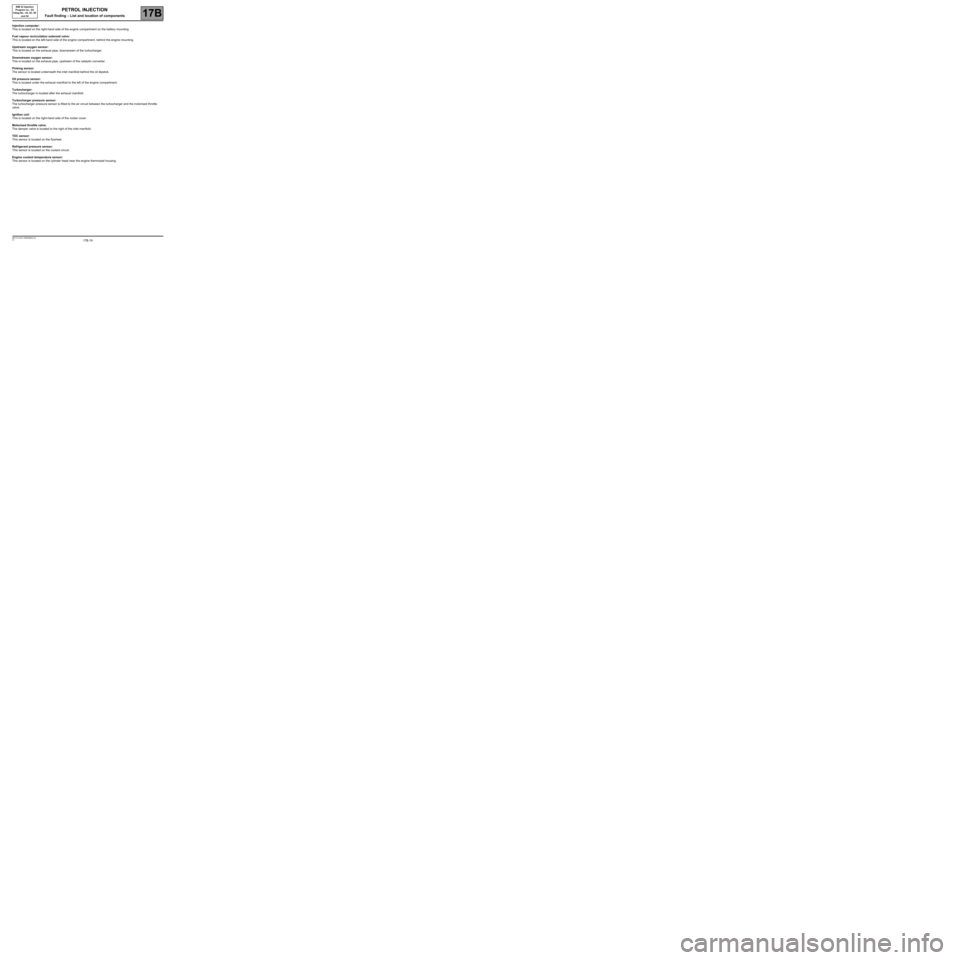
17B-19V7 MR-413-X44-17B000$040.mif
17B
SIM 32 Injection
Program no.: D3
Vdiag No.: 44, 4C, 50
and 54
Injection computer:
This is located on the right-hand side of the engine compartment on the battery mounting.
Fuel vapour recirculation solenoid valve:
This is located on the left-hand side of the engine compartment, behind the engine mounting.
Upstream oxygen sensor:
This is located on the exhaust pipe, downstream of the turbocharger.
Downstream oxygen sensor:
This is located on the exhaust pipe, upstream of the catalytic converter.
Pinking sensor:
The sensor is located underneath the inlet manifold behind the oil dipstick.
Oil pressure sensor:
This is located under the exhaust manifold to the left of the engine compartment.
Turbocharger:
The turbocharger is located after the exhaust manifold.
Turbocharger pressure sensor:
The turbocharger pressure sensor is fitted to the air circuit between the turbocharger and the motorised throttle
valve.
Ignition coil:
This is located on the right-hand side of the rocker cover.
Motorised throttle valve:
The damper valve is located to the right of the inlet manifold.
TDC sensor:
This sensor is located on the flywheel.
Refrigerant pressure sensor:
This sensor is located on the coolant circuit.
Engine coolant temperature sensor:
This sensor is located on the cylinder head near the engine thermostat housing.
PETROL INJECTION
Fault finding – List and location of components
Page 24 of 348
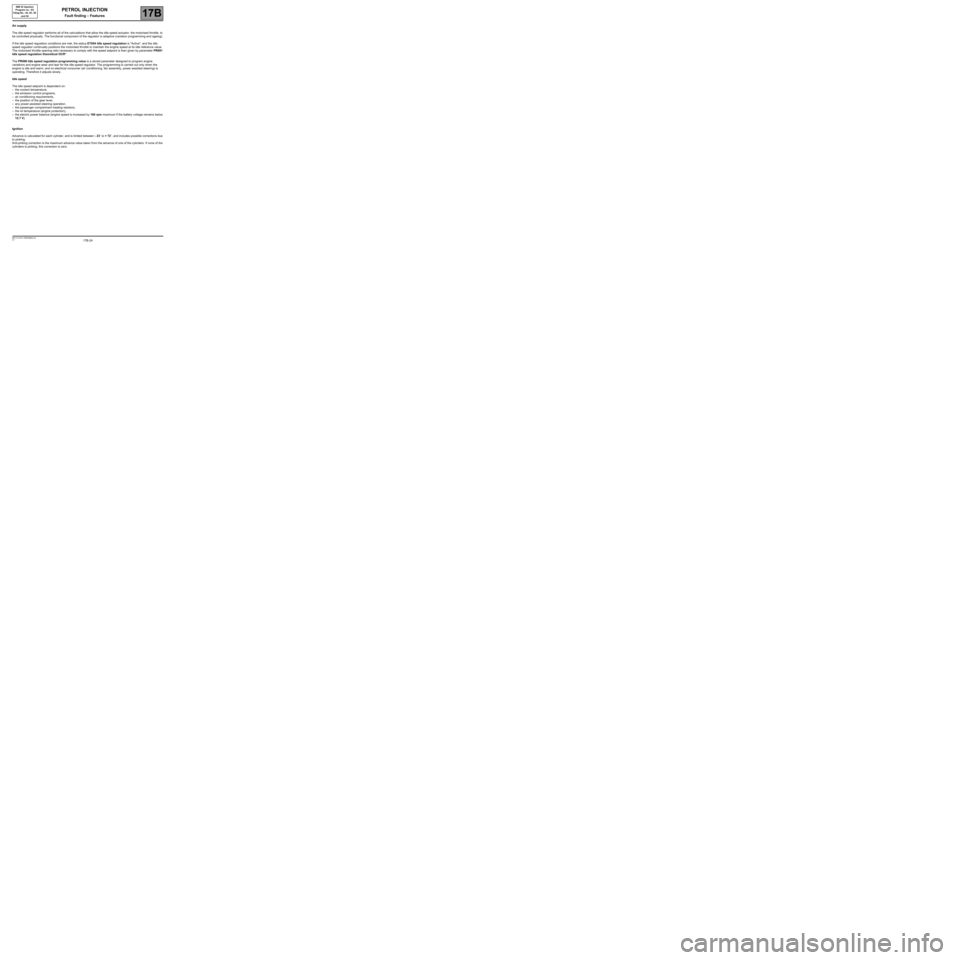
17B-24V7 MR-413-X44-17B000$060.mif
PETROL INJECTION
Fault finding – Features17B
SIM 32 Injection
Program no.: D3
Vdiag No.: 44, 4C, 50
and 54
Air supply
The idle speed regulator performs all of the calculations that allow the idle speed actuator, the motorised throttle, to
be controlled physically. The functional component of the regulator is adaptive (variation programming and ageing).
If the idle speed regulation conditions are met, the status ET054 Idle speed regulation is "Active", and the idle
speed regulator continually positions the motorised throttle to maintain the engine speed at its idle reference value.
The motorised throttle opening ratio necessary to comply with the speed setpoint is then given by parameter PR091
Idle speed regulation theoretical OCR*.
The PR090 Idle speed regulation programming value is a stored parameter designed to program engine
variations and engine wear and tear for the idle speed regulator. The programming is carried out only when the
engine is idle and warm, and no electrical consumer (air conditioning, fan assembly, power assisted steering) is
operating. Therefore it adjusts slowly.
Idle speed
The idle speed setpoint is dependent on:
–the coolant temperature,
–the emission control programs,
–air conditioning requirements,
–the position of the gear lever,
–any power-assisted steering operation,
–the passenger compartment heating resistors,
–the oil temperature (engine protection),
–the electric power balance (engine speed is increased by 160 rpm maximum if the battery voltage remains below
12.7 V).
Ignition
Advance is calculated for each cylinder, and is limited between - 23˚ to + 72˚, and includes possible corrections due
to pinking.
Anti-pinking correction is the maximum advance value taken from the advance of one of the cylinders. If none of the
cylinders is pinking, this correction is zero.
Page 30 of 348
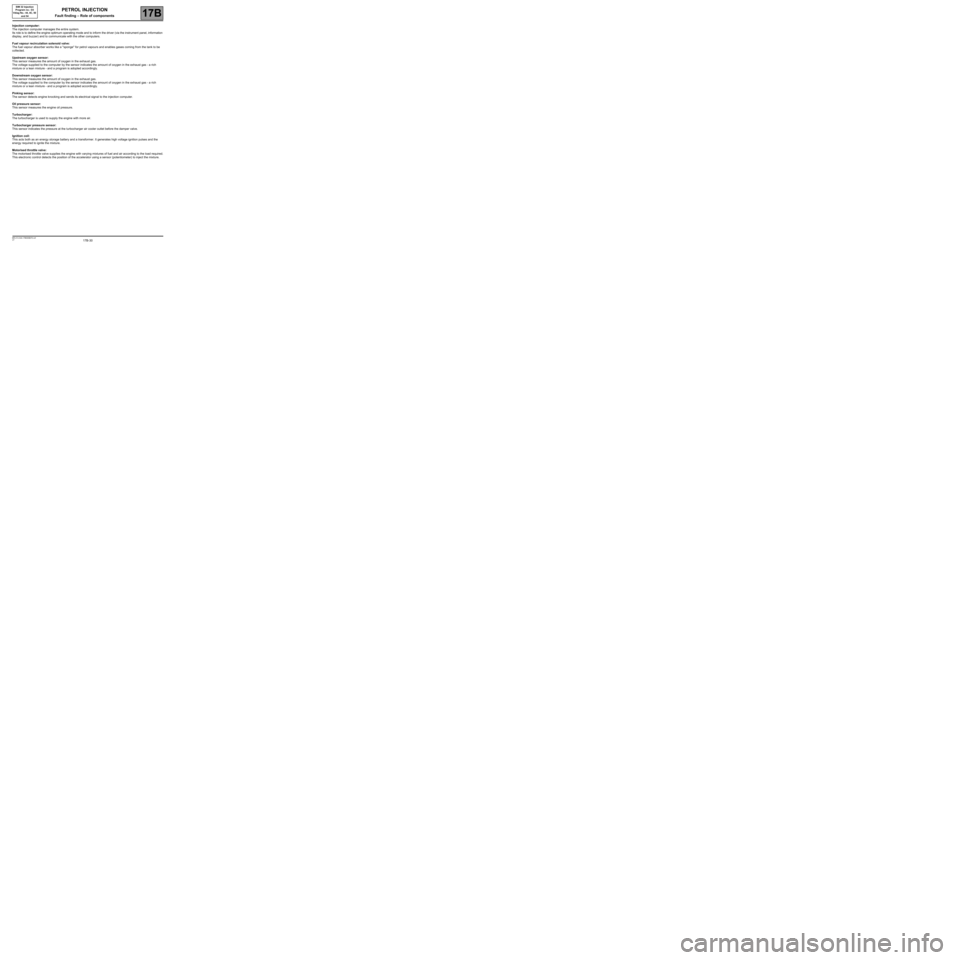
17B-30V7 MR-413-X44-17B000$070.mif
PETROL INJECTION
Fault finding – Role of components17B
SIM 32 Injection
Program no.: D3
Vdiag No.: 44, 4C, 50
and 54
Injection computer:
The injection computer manages the entire system.
Its role is to define the engine optimum operating mode and to inform the driver (via the instrument panel, information
display, and buzzer) and to communicate with the other computers.
Fuel vapour recirculation solenoid valve:
The fuel vapour absorber works like a ''sponge'' for petrol vapours and enables gases coming from the tank to be
collected.
Upstream oxygen sensor:
This sensor measures the amount of oxygen in the exhaust gas.
The voltage supplied to the computer by the sensor indicates the amount of oxygen in the exhaust gas - a rich
mixture or a lean mixture - and a program is adopted accordingly.
Downstream oxygen sensor:
This sensor measures the amount of oxygen in the exhaust gas.
The voltage supplied to the computer by the sensor indicates the amount of oxygen in the exhaust gas - a rich
mixture or a lean mixture - and a program is adopted accordingly.
Pinking sensor:
The sensor detects engine knocking and sends its electrical signal to the injection computer.
Oil pressure sensor:
This sensor measures the engine oil pressure.
Turbocharger:
The turbocharger is used to supply the engine with more air.
Turbocharger pressure sensor:
This sensor indicates the pressure at the turbocharger air cooler outlet before the damper valve.
Ignition coil:
This acts both as an energy storage battery and a transformer. It generates high voltage ignition pulses and the
energy required to ignite the mixture.
Motorised throttle valve:
The motorised throttle valve supplies the engine with varying mixtures of fuel and air according to the load required.
This electronic control detects the position of the accelerator using a sensor (potentiometer) to inject the mixture.
Page 34 of 348
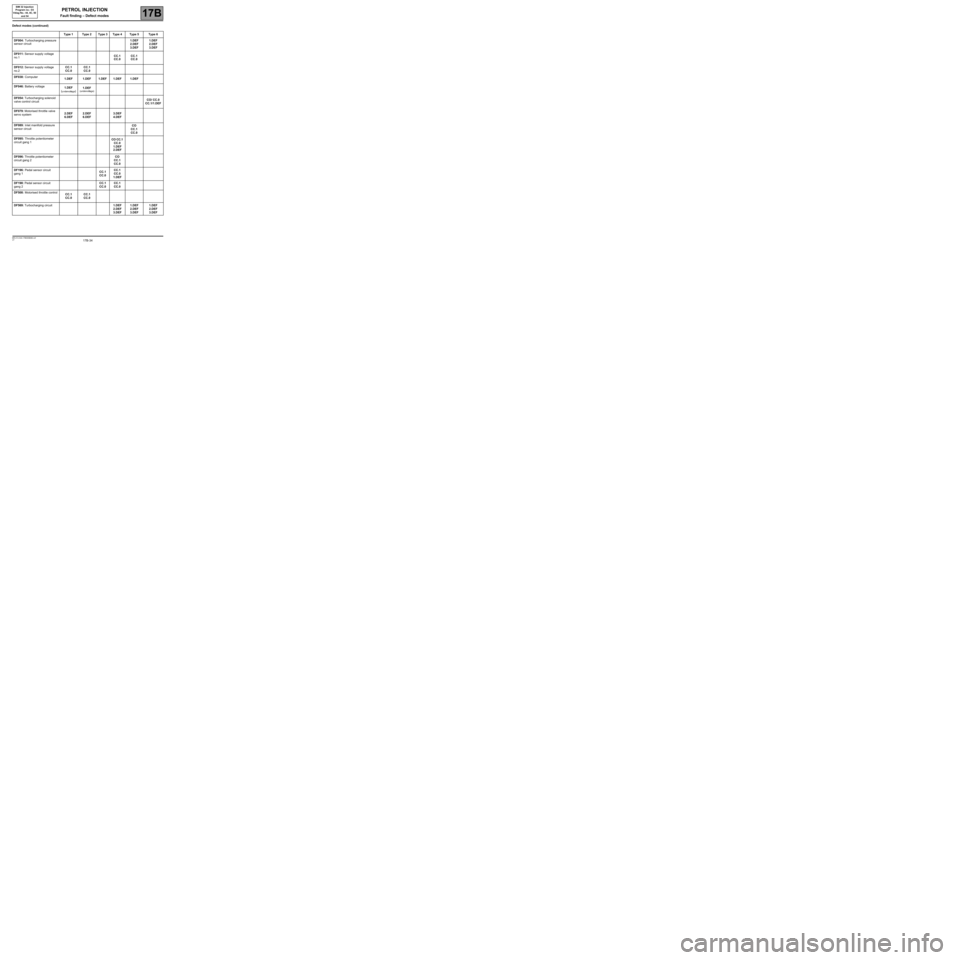
17B-34V7 MR-413-X44-17B000$080.mif
PETROL INJECTION
Fault finding – Defect modes17B
SIM 32 Injection
Program no.: D3
Vdiag No.: 44, 4C, 50
and 54
Defect modes (continued)
Type 1Type 2Type 3Type 4Type 5Type 6
DF004: Turbocharging pressure
sensor circuit1.DEF
2.DEF
3.DEF1.DEF
2.DEF
3.DEF
DF011: Sensor supply voltage
no.1CC.1
CC.0CC.1
CC.0
DF012: Sensor supply voltage
no.2CC.1
CC.0CC.1
CC.0
DF038: Computer1.DEF1.DEF1.DEF1.DEF1.DEF
DF046: Battery voltage1.DEF
(
undervoltage)
1.DEF
(undervoltage)
DF054: Turbocharging solenoid
valve control circuit CO/ CC.0
CC.1/1.DEF
DF079: Motorised throttle valve
servo system2.DEF
6.DEF2.DEF
6.DEF3.DEF
4.DEF
DF089: Inlet manifold pressure
sensor circuitCO
CC.1
CC.0
DF095: Throttle potentiometer
circuit gang 1CO CC.1
CC.0
1.DEF
2.DEF
DF096: Throttle potentiometer
circuit gang 2CO
CC.1
CC.0
DF196: Pedal sensor circuit
gang 1CC.1
CC.0CC.1
CC.0
1.DEF
DF198: Pedal sensor circuit
gang 2CC.1
CC.0CC.1
CC.0
DF508: Motorised throttle controlCC.1
CC.0CC.1
CC.0
DF569: Turbocharging circuit1.DEF
2.DEF
3.DEF1.DEF
2.DEF
3.DEF1.DEF
2.DEF
3.DEF
Page 35 of 348
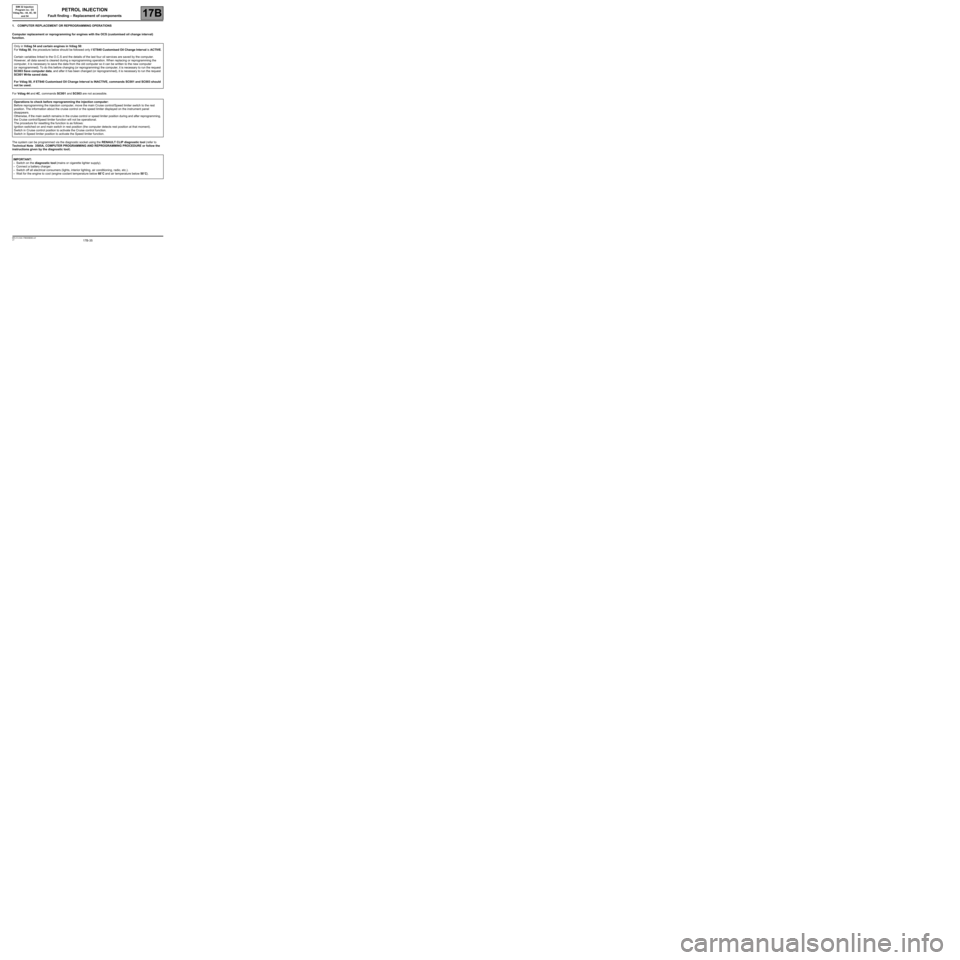
17B-35V7 MR-413-X44-17B000$090.mif
17B
SIM 32 Injection
Program no.: D3
Vdiag No.: 44, 4C, 50
and 54
1. COMPUTER REPLACEMENT OR REPROGRAMMING OPERATIONS
Computer replacement or reprogramming for engines with the OCS (customised oil change interval)
function.
For Vdiag 44 and 4C, commands SC001 and SC003 are not accessible.
The system can be programmed via the diagnostic socket using the RENAULT CLIP diagnostic tool (refer to
Technical Note 3585A, COMPUTER PROGRAMMING AND REPROGRAMMING PROCEDURE or follow the
instructions given by the diagnostic tool). Only in Vdiag 54 and certain engines in Vdiag 50:
For Vdiag 50, the procedure below should be followed only if ET840 Customised Oil Change Interval is ACTIVE.
Certain variables linked to the O.C.S and the details of the last four oil services are saved by the computer.
However, all data saved is cleared during a reprogramming operation. When replacing or reprogramming the
computer, it is necessary to save the data from the old computer so it can be written to the new computer
(or reprogrammed). To do this before changing (or reprogramming) the computer, it is necessary to run the request
SC003 Save computer data, and after it has been changed (or reprogrammed), it is necessary to run the request
SC001 Write saved data.
For Vdiag 50, if ET840 Customised Oil Change Interval is INACTIVE, commands SC001 and SC003 should
not be used.
Operations to check before reprogramming the injection computer:
Before reprogramming the injection computer, move the main Cruise control/Speed limiter switch to the rest
position. The information about the cruise control or the speed limiter displayed on the instrument panel
disappears.
Otherwise, if the main switch remains in the cruise control or speed limiter position during and after reprogramming,
the Cruise control/Speed limiter function will not be operational.
The procedure for resetting the function is as follows:
Ignition switched on and main switch in rest position (the computer detects rest position at that moment).
Switch in Cruise control position to activate the Cruise control function.
Switch in Speed limiter position to activate the Speed limiter function.
IMPORTANT:
–Switch on the diagnostic tool (mains or cigarette lighter supply).
–Connect a battery charger.
–Switch off all electrical consumers (lights, interior lighting, air conditioning, radio, etc.).
–Wait for the engine to cool (engine coolant temperature below 60˚C and air temperature below 50˚C).
PETROL INJECTION
Fault finding – Replacement of components
Page 36 of 348
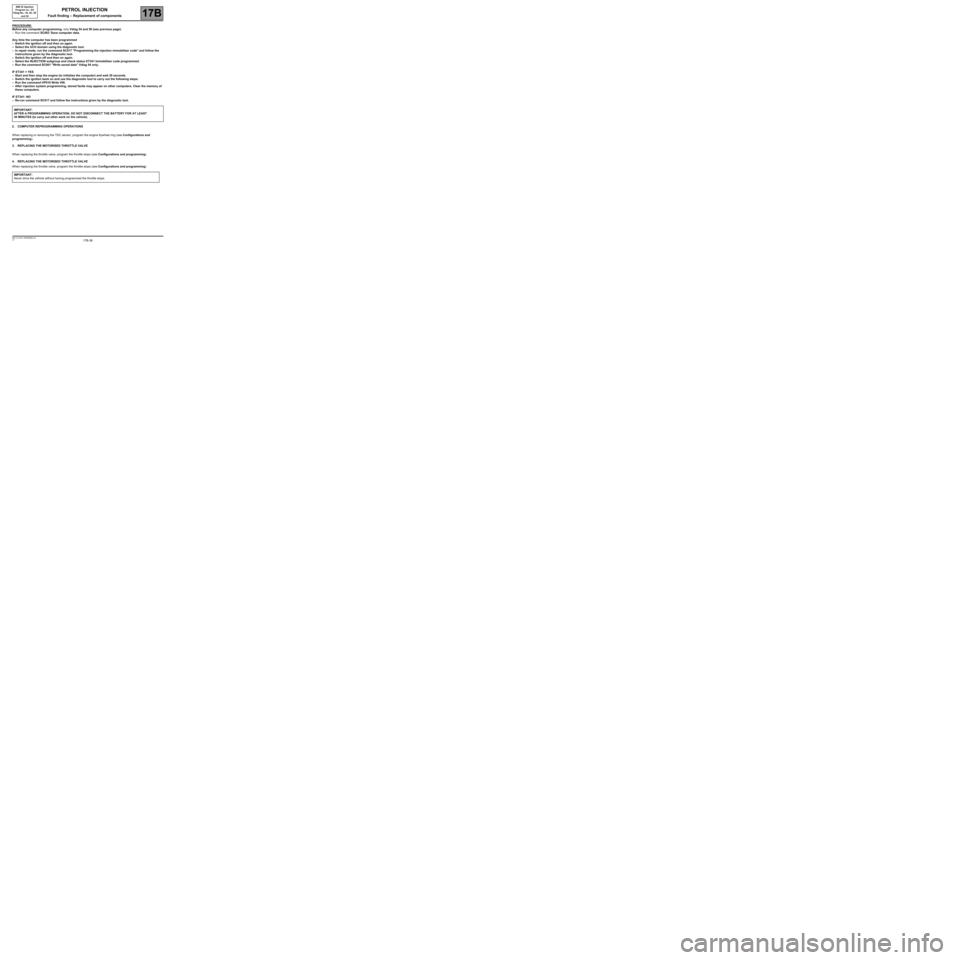
17B-36V7 MR-413-X44-17B000$090.mif
PETROL INJECTION
Fault finding – Replacement of components17B
SIM 32 Injection
Program no.: D3
Vdiag No.: 44, 4C, 50
and 54
PROCEDURE:
Before any computer programming, only Vdiag 54 and 50 (see previous page):
–Run the command SC003 'Save computer data.
Any time the computer has been programmed
–Switch the ignition off and then on again.
–Select the UCH domain using the diagnostic tool.
–In repair mode, run the command SC017 "Programming the injection immobiliser code" and follow the
instructions given by the diagnostic tool.
–Switch the ignition off and then on again.
–Select the INJECTION subgroup and check status ET341 Immobiliser code programmed.
–Run the command SC001 ''Write saved data" Vdiag 54 only.
IF ET341 = YES
–Start and then stop the engine (to initialise the computer) and wait 30 seconds.
–Switch the ignition back on and use the diagnostic tool to carry out the following steps:
–Run the command VP010 Write VIN.
–After injection system programming, stored faults may appear on other computers. Clear the memory of
these computers.
IF ET341: NO
–Re-run command SC017 and follow the instructions given by the diagnostic tool.
2. COMPUTER REPROGRAMMING OPERATIONS
When replacing or removing the TDC sensor, program the engine flywheel ring (see Configurations and
programming).
3. REPLACING THE MOTORISED THROTTLE VALVE
When replacing the throttle valve, program the throttle stops (see Configurations and programming).
4. REPLACING THE MOTORISED THROTTLE VALVE
When replacing the throttle valve, program the throttle stops (see Configurations and programming). IMPORTANT:
AFTER A PROGRAMMING OPERATION, DO NOT DISCONNECT THE BATTERY FOR AT LEAST
30 MINUTES (to carry out other work on the vehicle).
IMPORTANT:
Never drive the vehicle without having programmed the throttle stops.
Page 40 of 348
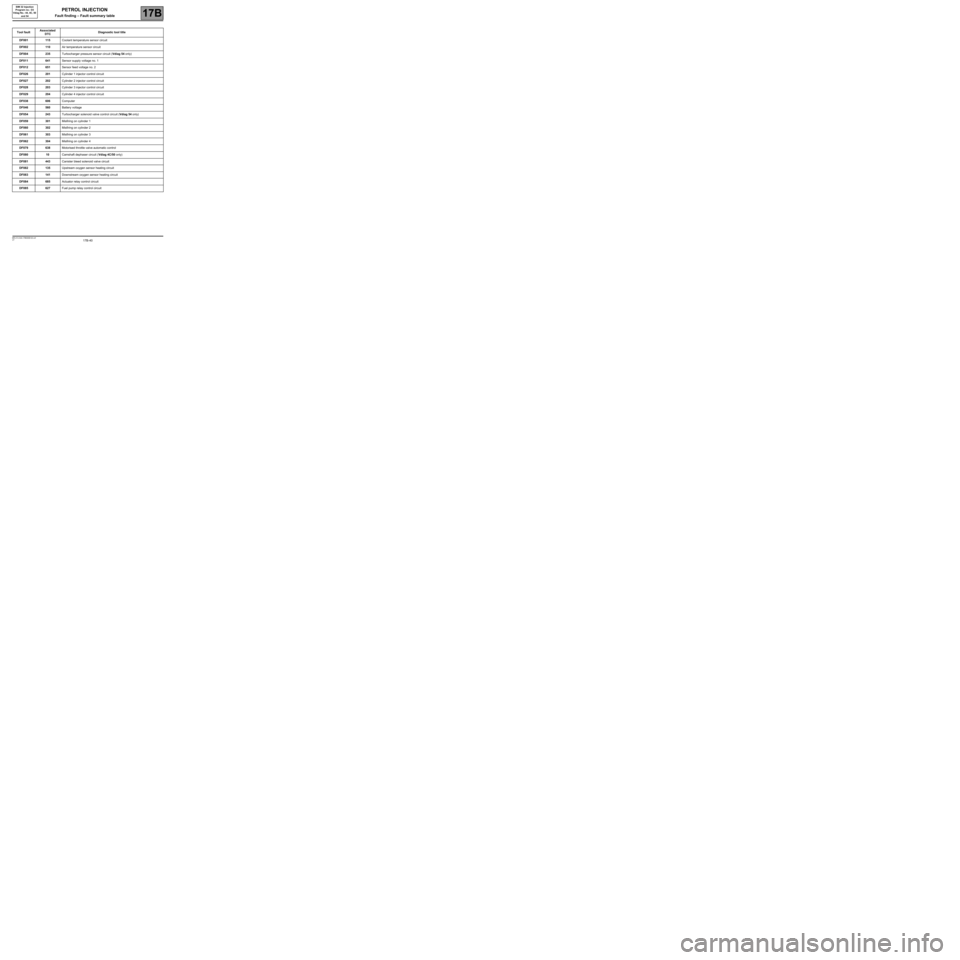
17B-40V7 MR-413-X44-17B000$120.mif
17B
SIM 32 Injection
Program no.: D3
Vdiag No.: 44, 4C, 50
and 54
Tool faultAssociated
DTCDiagnostic tool title
DF001115Coolant temperature sensor circuit
DF002110Air temperature sensor circuit
DF004235Turbocharger pressure sensor circuit (Vdiag 54 only)
DF011641Sensor supply voltage no. 1
DF012651Sensor feed voltage no. 2
DF026201Cylinder 1 injector control circuit
DF027202Cylinder 2 injector control circuit
DF028203Cylinder 3 injector control circuit
DF029204Cylinder 4 injector control circuit
DF038606Computer
DF046560Battery voltage
DF054243Turbocharger solenoid valve control circuit (Vdiag 54 only)
DF059301Misfiring on cylinder 1
DF060302Misfiring on cylinder 2
DF061303Misfiring on cylinder 3
DF062304Misfiring on cylinder 4
DF079638Motorised throttle valve automatic control
DF08010Camshaft dephaser circuit (Vdiag 4C/50 only)
DF081443Canister bleed solenoid valve circuit
DF082135Upstream oxygen sensor heating circuit
DF083141Downstream oxygen sensor heating circuit
DF084685Actuator relay control circuit
DF085627Fuel pump relay control circuit
PETROL INJECTION
Fault finding – Fault summary table